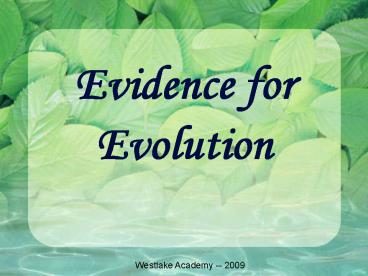Evidence for Evolution - PowerPoint PPT Presentation
1 / 36
Title:
Evidence for Evolution
Description:
A single organism may acclimate to an environment or have a mutation, but doesn't evolve. ... Fossil reconstruction of cetacean evolution. Fossil Evidence ... – PowerPoint PPT presentation
Number of Views:435
Avg rating:3.0/5.0
Title: Evidence for Evolution
1
Evidence for Evolution
Westlake Academy -- 2009
2
Evolution
- Change in the genetics of a population
- over time
- What does that mean?
3
Evolution
- Change in the genetics of a population
- over time
- What does that mean?
- Learning ?evolution
- Occurs over generations. A single organism may
acclimate to an environment or have a mutation,
but doesnt evolve.
4
Evidence for Evolution
- Fossils
- Homology
- Anatomical
- Embryological
- Molecular
- Lab and field studies
5
Fossil Evidence
- Help scientists reconstruct the timing,
appearance, and evolution of ancient and extinct
organisms - Biases in terms of
- what gets fossilized (hard parts)
- where fossils occur (fine sediments such as found
in river beds and volcanic eruptions)
6
Radiometric Dating of Fossils
- Scientists use ratios of radioactive
- isotopes found in fossils to date them.
7
Radiometric Dating of Fossils
- Scientists use ratios of radioactive
- isotopes found in fossils to date them.
- What are radioactive isotopes?
8
Radiometric Dating of Fossils
- Scientists use ratios of radioactive
- isotopes found in fossils to date them.
- What are radioactive isotopes?
- Isotopes elements that differ in the number of
neutrons. - Radioactive means that the extra neutrons or
protons will decay or break away over time.
9
Radiometric Dating of Fossils
- Scientists use ratios of radioactive
- isotopes found in fossils to date them.
- Each radioactive isotope decays at a specific,
- known rate.
- C14 has a half life of 5370 years
- U235 has a half life of 704 million years
- Rb87 has a half life of 48.8 billion years
10
Fossil Evidence
Fossil reconstruction of cetacean evolution
11
Fossil Evidence
Fossil reconstruction of hominid
evolution (anthropology.tamu.edu)
12
Homology Analogy
Homology refers to similarity between organisms
due to shared evolutionary ancestry. Analogy
occurs when organisms independently evolve
similar structures due to similar environmental
challenges.
13
Homology Analogy
Homology refers to similarity between organisms
due to shared evolutionary ancestry. Analogy
occurs when organisms independently evolve
similar structures due to similar environmental
challenges. Which one is useful for determining
how closely related two organisms are?
14
Homology Analogy
Homology refers to similarity between organisms
due to shared evolutionary ancestry. Analogy
occurs when organisms independently evolve
similar structures due to similar environmental
challenges. Which one is useful for determining
how closely related two organisms
are? Homology!
15
Anatomical Homology
www.evolution.berkeley.edu
16
Anatomical Homology
17
Homology in embryos
18
Molecular Homology
Organisms have molecular similarities as well --
similar genes, proteins, genetic code, etc
19
Anatomical Homology
Are all structures that look similar
homologies? No! Organisms can independently
evolve similar structures to solve similar
problems. These structures are analogous.
20
Anatomical Homology
21
Analogy vs Homology
22
Analogy
www.freewebs.com
23
Analogy
24
Analogy vs Homology
Can you think of other homologous or analogous
structures? How do you think a scientist could
determine whether a structure is homologous or
analogous?
25
Lab Field Studies
- Evolution has been documented many times in both
natural and laboratory populations. - Examples
- Antibiotic resistance in bacteria
- Color pattern in guppies
26
Antibiotic resistance
- Bacteria evolve rapidly (why?).
- If one bacterium develops a mutations
- that allows it to resist antibiotics, its
- offpring will survive well and multiply.
- (see http//www.sumanasinc.com/scienceinfocus/sif_
antibiotics.html)
27
Antibiotic Resistance Stats
- Gonorrhea
- 1960s no known resistance
- Now, 24 of cases in US are resistant and 98 of
cases in SE Asia - Pneumonia
- 1st penicillin-resistant strain observed in 1967
- By 1998, 34 were resistant
28
Antibiotic Resistance Stats
- E. coli
- In 1990, no E. coli known to be resistant to
flouroquinolines - In 1993, 28 resistant
- TB
- Antibiotic-resistant TB has been making the
headlines of international newspapers recently
29
Antibiotic resistance
Why would improper use or over-use of antibiotics
contribute to antibiotic resistance? When
should you use antibiotics? When shouldnt you?
30
Guppy coloration
Guppies in the wild vary strikingly in their
color patterns. John Endler wanted to
know why.
31
Guppy coloration
Endler found a negative correlation between the
colorfulness of males and the presence of
predators.
http//www.pbs.org/wgbh/evolution/sex/guppy/l
32
Guppy coloration
Endler found a negative correlation between the
colorfulness of males and the presence of
predators.
Why? How could you test your hypotheses?
33
Guppy coloration
Endler created artificial streams With
predators Without predators
15 generations
34
Guppy coloration
He even found that gravel type played a role.
15 generations
http//evolution.berkeley.edu
35
Guppy coloration
He even found that gravel type played a role.
15 generations
http//evolution.berkeley.edu
36
Guppy coloration
What conclusions could you draw from these
experiments? What else might you test?































